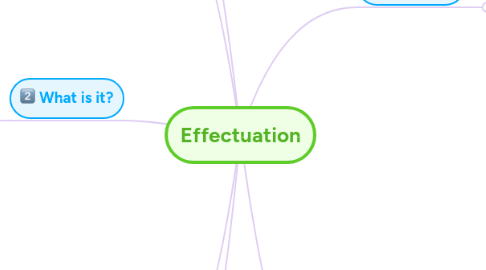
1. 101 overview
2. History
2.1. Introduced by Saras Sarasvathy in 2001
2.2. Since 1997 Sarasvathy conducted research among 27 expert entrepreneurs. Sarasvathy interviewed the entrepreneurs and let them solve cases in order to see how they think and where they start. Link with more detail: http://www.effectuation.org/research
2.2.1. 89% of the expert entrepreneurs used effectuation more often than causation
3. What is it?
3.1. Focusing on avail resources when considering what to build
3.1.1. Rather than focusing on end product first, then considering how to create it afterward (which is referred to as causation)
3.1.2. Example: Chef that looks at avail ingredients and considers what they can cook
3.1.2.1. Vs Chef that picks a meal then considers needed ingredients
3.2. Set of decision-making principles expert entrepreneurs are observed to employ in situations of uncertainty
3.3. Used in situations of uncertainty
3.3.1. Causal reasoning is used when the future is predictable
3.4. Effectual reasoning is a type of human problem solving
3.5. Definition
3.5.1. A logic of thinking that uniquely serves entrepreneurs in starting businesses
3.5.2. Provides a way to control a future that is inherently unpredictable
3.5.3. Heuristic
4. What it does
4.1. Ideas
4.1.1. Advances ideas toward sellable products and services with proven customers.
4.2. Stakeholder commitments
4.2.1. Using effectuation, the entrepreneur interacts in search of self-selecting partners to co-create the venture with.
4.3. Decisions
4.3.1. Experts entrepreneurs use a set of techniques that serve as the foundation for making decisions about what to do next.
5. Effectual Cycle
5.1. See last page of linked infographic pdf
6. Principles
6.1. Bird-in-hand
6.1.1. Start with what they have
6.1.1.1. Look at who they are + what they know + who they know
6.1.1.1.1. Identity
6.1.1.1.2. Competencies
6.1.1.1.3. Contacts
6.1.1.2. Important: Does not start with given goal, but instead starts with what they have
6.1.2. Important factors at this point
6.1.2.1. Education
6.1.2.2. Tastes
6.1.2.3. Experience
6.1.3. Stage to look at the 3 F's
6.1.3.1. Friends
6.1.3.2. Family
6.1.3.3. Fools
6.2. Affordable loss
6.2.1. Focuses on possible losses and how they can be minimised
6.2.1.1. Does not focus on possible profits
6.3. Crazy quilt
6.3.1. Cooperate with parties they trust
6.3.1.1. Can limit affordable loss by giving pre-commitment
6.4. Lemonade
6.4.1. Will look at how to leverage contingencies
6.4.1.1. Surprises are not necessarily seen as something bad, but as opportunities to find new markets.
6.5. Pilot-in-the-plane
6.5.1. All the previous principles are put together.
6.5.1.1. The future cannot be predicted, but entrepreneurs can control some of the factors which determine the future.
7. Resources
7.1. Carter, S., & Jones-Evans, D. (Eds.). (2006). Enterprise and small business: principles, practice and policy. Pearson Education.
7.1.1. Chapter 8: The psychology of the entrepreneur
7.2. http://www.effectuation.org/
7.2.1. Quick overview video: http://www.effectuation.org/video/10-myths-entrepreneurship-university-stgallen
7.3. Saras Sarasvathy
7.3.1. Effectuation - 3 pager overview
7.3.2. What makes entrepreneurs entrepreneurial
7.3.3. Affordable Loss
7.3.4. 2 ways - New Venture Performance
